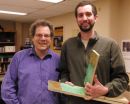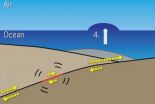(Press-News.org) PULLMAN, Wash.—Don't get him wrong: Fred Gittes is, in his words, "extremely squeamish."
But then a scientist with forensics training told him that crime scene investigators could use a better way to analyze blood spatters. The physicist in Gittes rose to the challenge.
"It seems as though what was being done was very crude from a physics point of view and that intrigued me," he says.
Along with Chris Varney, a doctoral candidate in physics, Gittes has worked out a system that can often determine exactly where blood spatters originate, a critical piece of evidence in not only solving a crime but securing a conviction. A paper on their research, demurely titled "Locating the Source of Projectile Fluid Droplets," has now been accepted for publication in the American Journal of Physics and posted online.
Until now, investigators have been able to determine the direction a drop of blood has come from, with a stain's elliptical shape practically pointing to it. They've even been able to nail down a source along a vertical line. But the tougher part is figuring out how high up the source was.
"I talked informally with a public defender and he said that it's crucial to know the height because so often it's a self-defense issue," Gittes says. "A defendant may claim that a victim was standing rather than sitting. That's a big deal, apparently."
Gittes and Varney started tackling the problem with a clapper—two boards on a hinge that could be clapped over a liquid, producing a spatter from a known and measurable height and angle. To get a liquid with blood-like impact shapes, they tinkered with corn syrup, food coloring and a variety of sauces before settling on a blend of Ashanti chicken wing sauce and Ivory dish soap.
Most of the math they used is at about the level of first-semester college physics. We'll spare you most of it, except to say they worked back from measurements of known spatters and sources and found that well known equations of projectile motion could be used to develop a formula giving them the height of a liquid's origin.
They also realized that, plotted on a graph with x and y axes, data points on specific drops form a neat line when the formula is working correctly. If drops are launched from too wide a range of angles, the method won't work and the data points won't line up, preventing investigators from making a false conclusion.
Gittes says he is chiefly interested in the new approach as a teaching tool, and a WSU geologist has expressed an interest in using similar methods to study lava fountains and volcanic debris. Gittes says he is content to leave any forensic application to crime scene investigators. Besides, he is way too squeamish.
INFORMATION:
An abstract of the Varney-Gittes paper can be seen at http://arxiv.org/abs/1102.5134.
WSU physicists devise new way to analyze a bloody crime scene
Chicken wing sauce and trigonometry brought to bear on CSI enigma
2011-05-24
ELSE PRESS RELEASES FROM THIS DATE:
Unusual earthquake gave Japan tsunami extra punch, say Stanford scientists
2011-05-24
The magnitude 9 earthquake and resulting tsunami that struck Japan on March 11 were like a one-two punch – first violently shaking, then swamping the islands – causing tens of thousands of deaths and hundreds of billions of dollars in damage. Now Stanford researchers have discovered the catastrophe was caused by a sequence of unusual geologic events never before seen so clearly.
"It was not appreciated before this earthquake that this size of earthquake was possible on this plate boundary," said Stanford geophysicist Greg Beroza. "It was thought that typical earthquakes ...
Seeing an atomic thickness
2011-05-24
Scientists from the National Physical Laboratory (NPL), in collaboration with Linköping University, Sweden, have shown that regions of graphene of different thickness can be easily identified in ambient conditions using Electrostatic Force Microscopy (EFM).
The exciting properties of graphene are usually only applicable to the material that consists of one or two layers of the graphene sheets. Whilst synthesis of any number of layers is possible, the thicker layers have properties closer to the more common bulk graphite.
For device applications one- and two-layer graphene ...
Frequent moderate drinking of alcohol is associated with a lower risk of fatty liver disease
2011-05-24
In a large study of men in Japan, the presence of fatty liver disease by ultrasonography showed an inverse ( reduced risk) association with the frequency of moderate alcohol consumption; however, there was some suggestion of an increase in fatty liver disease with higher volume of alcohol consumed per day. Moderate drinkers had lower levels of obesity than did non-drinkers, and both obesity and metabolic abnormalities were positively associated with fatty liver disease.
These findings support the results of a number of other recent studies showing that moderate drinking ...
We have the technology for creating sustainable energy systems of the future
2011-05-24
We still need to halt the increase of global carbon emissions before 2020 and in the long term reduce emissions by at least 50% up to 2050. Ultimately, we will have to reduce carbon emissions to close to zero or even remove carbon completely from the atmosphere.
However, climate change is not the only energy challenge:
We need energy services to drive global economic development
We need to provide equal access to modern energy worldwide
We need to provide electricity to the 25% of the world's population still without electricity
We need to provide modern energy ...
Lifestyle counseling and glycemic control in patients with diabetes: True to form?
2011-05-24
Boston, MA – Electronic medical records (EMRs) have been in use for more than 30 years, but have only increased in utilization in recent years, due in part to research supporting the benefits of EMRs and federal legislation. As EMRs have become a standard in medical care, there is a need for additional research of how the system and usage can be refined. A group of researchers from Brigham and Women's Hospital have done just that, and discovered that one way false information can make its way into EMRs is due to users' reliance on copying and pasting material within the ...
Expert discovers simple method of dealing with harmful radioactive iodine
2011-05-24
A novel way to immobilise radioactive forms of iodine using a microwave, has been discovered by an expert at the University of Sheffield.
Iodine radioisotopes are produced by fission of uranium fuel in a nuclear reactor. Radioactive iodine is of concern because it is highly mobile in the environment and selective uptake by the thyroid gland can pose a significant cancer risk following long term exposure. Furthermore, iodine-129, which is a type of radioactive iodine, has an extremely long half life of 15.7 million years, so is one of the most significant long term hazards ...
MIT research: What makes an image memorable?
2011-05-24
CAMBRIDGE, Mass. -- Next time you go on vacation, you may want to think twice before shooting hundreds of photos of that scenic mountain or lake.
A new study from MIT neuroscientists shows that the most memorable photos are those that contain people, followed by static indoor scenes and human-scale objects. Landscapes? They may be beautiful, but they are, in most cases, utterly forgettable.
"Pleasantness and memorability are not the same," says MIT graduate student Phillip Isola, one of the lead authors of the paper, which will be presented at the IEEE Conference on ...
WSO2 Summer School Features Free Class on SOA Security Policy Enforcement for the Enterprise
2011-05-24
The recent data breaches faced by Sony, Epsilon and TJX once again highlight the risks that lapses in governance pose to enterprise data security. To protect valuable company and customer data, enterprises need to implement IT security governance as a mechanism for managing authorization and access via pre-defined rules and policies. Industry-standard technologies, such as the eXtensible Access Control Markup Language (XAMCL), are helping to facilitate this governance by enabling more efficient and nuanced security policy enforcement.
IT architects and developers can ...
2 Greenland glaciers lose enough ice to fill Lake Erie
2011-05-24
COLUMBUS, Ohio – A new study aimed at refining the way scientists measure ice loss in Greenland is providing a "high-definition picture" of climate-caused changes on the island.
And the picture isn't pretty.
In the last decade, two of the largest three glaciers draining that frozen landscape have lost enough ice that, if melted, could have filled Lake Erie.
The three glaciers – Helheim, Kangerdlugssuaq and Jakobshavn Isbrae – are responsible for as much as one-fifth of the ice flowing out from Greenland into the ocean.
"Jakobshavn alone drains somewhere between ...
Nearby supernova factory ramps up
2011-05-24
A local supernova factory has recently started production, according to a wealth of new data from NASA's Chandra X-ray Observatory on the Carina Nebula. This discovery may help astronomers better understand how some of the Galaxy's heaviest and youngest stars race through their lives and release newly-forged elements into their surroundings.
Located in the Sagittarius-Carina arm of the Milky Way a mere 7,500 light years from Earth, the Carina Nebula has long been a favorite target for astronomers using telescopes tuned to a wide range of wavelengths. Chandra's extraordinarily ...
LAST 30 PRESS RELEASES:
Air pollution exposure and birth weight
Obstructive sleep apnea risk and mental health conditions among older adults
How talking slows eye movements behind the wheel
The Ceramic Society of Japan’s Oxoate Ceramics Research Association launches new international book project
Heart-brain connection: international study reveals the role of the vagus nerve in keeping the heart young
Researchers identify Rb1 as a predictive biomarker for a new therapeutic strategy in some breast cancers
Survey reveals ethical gaps slowing AI adoption in pediatric surgery
Stimulant ADHD medications work differently than thought
AI overestimates how smart people are, according to HSE economists
HSE researchers create genome-wide map of quadruplexes
Scientists boost cell "powerhouses" to burn more calories
Automatic label checking: The missing step in making reliable medical AI
Low daily alcohol intake linked to 50% heightened mouth cancer risk in India
American Meteorological Society announces Rick Spinrad as 2026 President-Elect
Biomass-based carbon capture spotlighted in newly released global climate webinar recording
Illuminating invisible nano pollutants: advanced bioimaging tracks the full journey of emerging nanoscale contaminants in living systems
How does age affect recovery from spinal cord injury?
Novel AI tool offers prognosis for patients with head and neck cancer
Fathers’ microplastic exposure tied to their children’s metabolic problems
Research validates laboratory model for studying high-grade serous ovarian cancer
SIR 2026 delivers transformative breakthroughs in minimally invasive medicine to improve patient care
Stem Cell Reports most downloaded papers of 2025 highlight the breadth and impact of stem cell research
Oxford-led study estimates NHS spends around 3% of its primary and secondary care budget on the health impacts of heat and cold in England
A researcher’s long quest leads to a smart composite breakthrough
Urban wild bees act as “microbial sensors” of city health.
New study finds where you live affects recovery after a hip fracture
Forecasting the impact of fully automated vehicle adoption on US road traffic injuries
Alcohol-related hospitalizations from 2016 to 2022
Semaglutide and hospitalizations in patients with obesity and established cardiovascular disease
Researchers ‘listen in’ to embryo-mother interactions during implantation using a culture system replicating the womb lining
[Press-News.org] WSU physicists devise new way to analyze a bloody crime sceneChicken wing sauce and trigonometry brought to bear on CSI enigma



